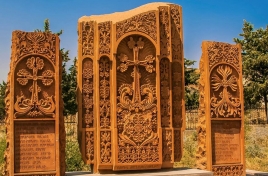Khachkar
Thursday, October 14, 2021
A khachkar, also known as an Armenian cross-stone is a carved, memorial stele bearing a cross, and often with additional motifs such as rosettes, interlaces, and botanical motifs. Khachkars are characteristic of Medieval Christian Armenian art.
Since 2010, khachkars, their symbolism and craftsmanship are inscribed in the UNESCO list of Intangible Cultural Heritage.
The most common khachkar feature is a cross surmounting a rosette or a solar disc. The remainder of the stone face is typically filled with elaborate patterns of leaves, grapes, pomegranates, and bands of interlace. Occasionally a khachkar is surmounted by a cornice sometimes containing biblical or saintly figures.
Most early khachkars were erected for the salvation of the soul of either a living or a deceased person. Otherwise they were intended to commemorate a military victory, the construction of a church, or as a form of protection from natural disasters.
The most common location for early khachkars was in a graveyard. However, Armenian gravestones take many other forms, and only a minority are khachkars.
The first true khachkars appeared in the 9th century, during the time of Armenian revival after liberation from Arab rule. The oldest khachkar with a known date was carved in 879 (though earlier, cruder, examples exist). Erected in Garni, it is dedicated to queen Katranide I, the wife of king Ashot I Bagratuni. The peak of the khachkar carving art was between the 12th and the 14th centuries. The art declined during the Mongol invasion at the end of the 14th century. It revived in the 16th and 17th centuries, but the artistic heights of the 14th century were never achieved again. Today, the tradition still remains, and one can still see khachkar carvers in some parts of Yerevan.
About 40,000 khachkars survive today. Most of them are free standing, though those recording donations are usually built into monastery walls. The following three khachkars are believed[by whom?] to be the finest examples of the art form:
- One in Geghard, carved in 1213, probably by master Timot and master Mkhitar
- The Holy Redeemer khachkar in Haghpat (see gallery), carved in 1273 by master Vahram
- A khachkar in Goshavank, carved in 1291 by master Poghos.
A number of good examples have been transferred to the Historical Museum in Yerevan and beside the cathedral in Echmiadzin. The largest surviving collection of khachkars is in Armenia, at Noraduz cemetery on the western shore of the Lake Sevan, where an old graveyard with around 900 khachkars from various periods and of various styles can be seen. The largest number was formerly located at the Armenian cemetery in Julfa in the Nakhichevan Autonomous Republic of Azerbaijan, which contained approximately 10,000 khachkars in 1648. The number of khachkars dwindled over time through destruction of various causes until the only 2,700 khachkars remained in 1998, when the Azerbaijani government embarked on a systematic campaign destroying and leveling the entire medieval cemetery between 1998 and 2005.
The art of carving khachkars has witnessed a rebirth as a symbol of Armenian culture in the 20th century.
There are hundreds of khachkars worldwide, many of which are memorials to commemorate the victims of the Armenian genocide. Khachkars have been placed in various locations, including at the Vatican Museums, Canterbury Cathedral's memorial garden, St Mary's Cathedral, Sydney, Colorado State Capitol, Temple of Peace, Cardiff, Christ Church Cathedral, Dublin, and elsewhere.
According to one count, there are nearly 30 khachkars on public locations in France.
Armenian khachkars have been acquired or donated to many museums or temporarily represented at significant exhibitions all around the world such as at the British Museum, the Metropolitan Museum of Art or the Special Exhibition of the National Museum of Ethnology, Osaka, Japan.





